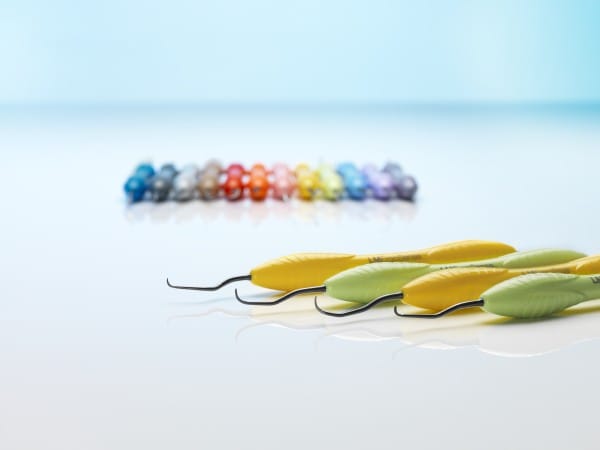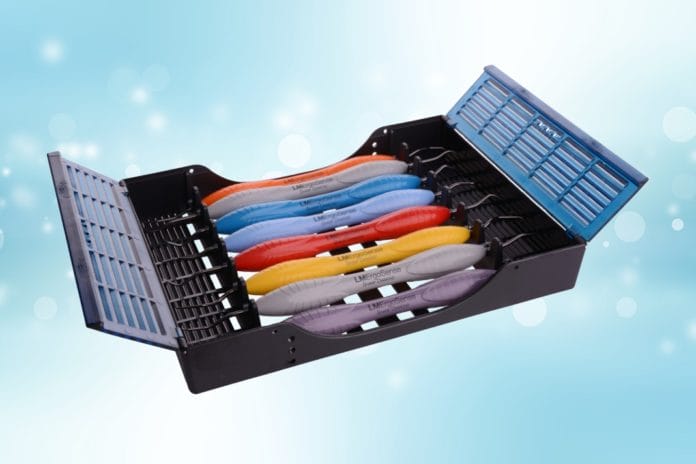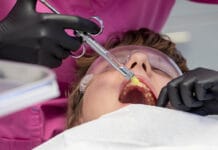Disclosure: This article is sponsored content from Planmeca as part of our sponsored partner program.
A newfound appreciation for sharp, reliable curettes and scalers is sure to have swept the dental hygiene nation recently. With the current COVID-19 pandemic enveloping the world, a new set of guidelines for practicing dentistry emerged to assist in keeping the dental professional and patients as safe as possible.
The everyday routines we habitually practiced without fail were shaken up a bit, and practitioners around the nation suddenly found themselves adapting to something largely new and, for some, unfamiliar.
For years, dental hygienists have struggled with maintaining safe ergonomics, leading the majority to fall back on a coveted piece of equipment known as the ultrasonic. However, due to the high volume of aerosols this calculus-blasting machine generates, the Centers for Disease Control and Prevention, the American Dental Association, and the American Dental Hygienists’ Association recommend that dental professionals refrain from using aerosol-producing equipment when possible until the pandemic is over.6-8
It is no secret retrieved from a vault that dental professionals are at high risk for musculoskeletal disorders (MSD). In fact, the hand and wrist regions were the most prevalent regions documented with MSD for dental hygienists (60% to 69.5%).1 It is inevitable that dental hygienists use repetitive motions as they work diligently to remove biofilm, calculus, and stain from the oral cavity.
Keeping on Edge
The repetition of our career can leave the physicality of our bodies in poor shape if targeted ergonomics is not practiced. Among all occupations in the U.S., dental hygiene was ranked the highest by the Bureau of Labor Statistics in the number of carpal tunnel syndromes cases per 1,000 employees.3 Making smart, calculated decisions about even the simplest of aspects of a dental hygiene career can provide a large impact for years to come.
Many dental hygienists would agree that dental instruments have a way of making or breaking an appointment. There is nothing worse than attempting to use a dull instrument to do a job crafted for a sharp edge. Instrument selection is pivotal for efficiency and the reduction of clinician injury.
While keeping instruments sharpened is a key factor in this equation, many fail to live up to the task. With dental instruments dulling after just 15 strokes, the job of instrument maintenance becomes increasingly overwhelming.2 And let’s be frank, many dental professionals do not have the time needed to allocate for the task or do not possess the skill set required to recreate the instrument’s sharp edge.
Reducing Risk of Injury
Dental instruments have many attributes that can help contribute to reducing injury while enhancing comfort. Because of the forced pinch and grasp to successfully hold an instrument, the handle itself is an important quality of a dental instrument. The average pinch force exerted during dental scaling is between 11% and 20% of the maximum pinch strength.3
Therefore, a lighter instrument bearing a wider handle is ideal. Instruments with a large diameter (10 mm) and a lightweight (15 g) require the least amount of muscle load and pinch force.3 Studies also show that clinicians have less upper arm pain when using instruments with wider handles.4
In addition to a wider handle, one with an appealing grip is also imperative to instrumentation. Remember in elementary school when you used a pencil gripper on your No. 2 lead pencil? A wider, softer grip on a dental instrument works in the same manner by providing comfort. A spongier handle accompanied with an easy to grip material will aid the clinician’s grasp which will help decrease injury.
A study comparing various sizes and weights of instruments proved that silicone handles were found to be more usable and cause lower perceived musculoskeletal strain.4
LM Sharp Diamond Instruments

Recently, I had the opportunity to try LM sharpen-free Sharp Diamond™ instruments, distributed in the United States by Planmeca. My initial reaction was that the vibrantly colored instruments were easily identified just by color alone. This contributed to the flow of the appointment as I was able to readily identify which instrument I needed next as opposed to searching through a parallel arrangement of silver instruments.
The 14mm medical-grade, silicone-coated LM-ErgoSense® handle was very easy to grasp, and it never slipped from my grip nor did they roll around aimlessly on my tray without the LM cassette to house the instruments. The silicone provides a nice feel to the instrument for the hygienist who must labor harder to remove more tenacious deposits yet providing comfort in the process.
The LM-ErgoSense® handle receives the highest ergonomics rating. This discovery came as no surprise as I found that, when working on patients with moderate subgingival calculus, my hands seemed less fatigued compared to a heavier, smaller-handled instrument. The LM Sharp Diamond™ instrument is designed with a metal alloy core that is consistent from tip to tip, which aids in tactile sensitivity. The instruments almost feel weightless, making the scaling process much easier on the hands, especially for lengthier procedures.
In addition to the handle, the LM Sharp Diamond™ instruments have an extremely hard micro-coating that uses physical vapor deposition (PVD) technology that allows the instrument to retain shape, be razor-sharp, and be more wear-resistant.
This is a dental hygienist’s dream! After consistently using the instruments for several weeks, I can truthfully state that I did not notice a dullness. This sensation is unlike most instruments after repeated use. The instrument’s cutting edge offered a “bite” with each stroke. LM Sharp Diamond™ instruments surpass the competitors’ coated, sharpen-free instrument in wear resistance and has an 82% decrease in wear compared to other typical hand instruments.5
The sharpen-free instrument is a beneficial attribute for busy and fatigued dental hygienists who simply do not have the time or skillset to sharpen instruments.
LM-Syntettes

In conjunction with ergonomics, practicality serves to make a dental instrument even more useful. The LM-Syntettes™ are a combination of Gracey and Universal curettes that allows two instruments to do the work of four. The reduced need to switch instruments allows the practitioner to perform more fluidly as the Syntettes™ are equipped with a rounded toe with two elliptical cutting edges, allowing for movement from mesial to distal without flipping and buccal to lingual without changing instruments.
I found the Mini Syntette™ (Gracey 11/12 & Gracey 13/14) extremely innovative and very useful among patients who had tighter interproximal spacing. I found myself swiveling less to grab a new instrument to finish a task.
LM SharpJack Sickle SD

The LM SharpJack™ Sickle SD is an instrument that every dental hygienist needs in their dental setup. This instrument looks and operates similarly to the H6/H7, which has long been a favorite among many.
This scaler has long, thin blades that can operate in tight spaces interproximally, and, because of its optimally angulated shank, it can be used both anteriorly and posteriorly. In addition to being universal, the LM SharpJack™ can also be used on all four surfaces. Having an instrument with so much versatility contributed to my time management and assisted in making my appointments smoother.
To put it bluntly, I SharpJacked everything!
The sharp, durable edges of the LM Sharp Diamond™ instruments are exactly what dental hygienists around the country need right now and, well, forever. I have now been using my instruments for nearly a month and have yet to notice any dulling in the blades.
I love having a sharp instrument assist in my efficiency as a dental hygienist. As a seasoned dental professional, I regret not trying these instruments sooner. I feel confident that they will help alleviate some of the fatigue my hands have experienced throughout the years. It is never too late to try something new and make a positive change!
Click Here to Learn More about LM Instruments
References
- Hayes, M.J., et al. A systematic review of musculoskeletal disorders among dental professionals. International Journal of Dental Hygiene. 2009; 7(3):159-65. doi:10.1111/j.1601-5037.2009.00395.x.
- Vavrosky, K. Ask Kara RDH: How Often Should I Sharpen My Instruments? Today’s RDH. 30 Mar. 2018. Retrieved from https://www.todaysrdh.com/ask-kara-rdh-how-often-should-i-sharpen-my-instruments.
- Dong, H., et al. The effect of tool handle shape on hand muscle load and pinch force in a simulated dental scaling task. Applied ergonomics. 2007; 38(5): 525-31. doi:10.1016/j.apergo.2006.09.002.
- Pelkonen, A., Oy, S. The Value of An Ergonomic Instrument Grip. LM Dental. Retrieved from http://publications.lm-dental.com/LM-Dental/Articles/LM_article_the_value_of_an_ergonomic_instrument_grip_article.pdf.
- Leppäniemi, J., et al. The influence of PVD coatings on the wear performance of steel dental currettes. Key Engineering Materials. 2016; 674: 289-295.
- 6. ADHA Interim Guidance on Returning to Work. American Dental Hygienists’ Association. 8 Aug. 2020. Retrieved from https://www.adha.org/adha-interim-guidance-on-returning-to-work.
- Summary of ADA Guidance During the COVID-19 Crisis. American Dental Association. 24 June 2020. Retrieved from: https://success.ada.org/~/media/CPS/Files/COVID/COVID-19_Int_Guidance_Summary.pdf.
- Guidance for Dental Settings. Centers for Disease Control and Prevention. 8 Aug. 2020. Retrieved from https://www.cdc.gov/coronavirus/2019-ncov/hcp/dental-settings.html.










